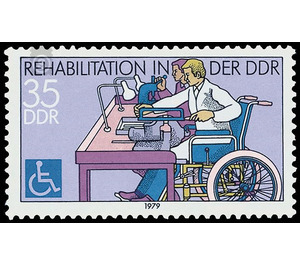Rehabilitation of the disabled - Germany / German Democratic Republic 1979 - 35 Pfennig
Theme: Health & Human
| Country | Germany / German Democratic Republic |
| Issue Date | 1979 |
| Face Value | 35.00 |
| Color | violet |
| Perforation | K 13:12 1/2 |
| Printing Type | offset |
| Stamp Type | Postage stamp |
| Item Type | Stamp |
| Chronological Issue Number | 2174 |
| Chronological Chapter | GER-DDR |
| SID | 407938 |
| In 14 Wishlists | |
Rehabilitation in the GDR With representations from the rehabilitation in the GDR, the Ministry of Post and Telecommunications of the German Democratic Republic issued two multicolored special postage stamps. Rehabilitation successes in the GDR 1979 is the last year of the "Decade of Rehabilitation" proclaimed by the International Rehabilitation Society, which has succeeded in advancing global progress in many areas of reahbilitation for the well-being of the injured person. The German Democratic Republic can point to great successes in medical, educational, vocational and social rehabilitation. The unity of economic and social policy increasingly allowed to realize exemplary and internationally recognized rehabilitation measures for all concerned citizens. Special reference can be made to outstanding rehabilitation results in educational rehabilitation and vocational rehabilitation. Vocational rehabilitation develops the working capacity of the citizens who are injured by their health, both in their individual and societal interests. The diverse forms of organization of the work process have so specialized work demands and so far developed possibilities of designing workplaces that there is practically a possibility of work for every injured person. There are, in particular, three categories of citizens who need professional rehabilitation: - severely and severely damaged persons with physical disabilities and those with sensory impairments with inpatient findings as well as mentally injured adolescents; Citizens suffering from chronic afflictions with physical or psychological intellectual damage; - Working people who, after a severe acute health condition, require gradual adaptation to normal working conditions. Identifying the groups that need vocational rehabilitation measures already demonstrates the versatility of the necessary measures. The special occupational fields of application range from the employment in the work therapy, over the Schonarbeit, the adapted heavy damaged workplace up to the forms of the protected work. The magnitude of this social task is clarified by the fact that companies and administrations still have a binding duty to realize the number of seriously injured persons to be employed at least in the ratio 1:10 to the number of employees. Pedagogical rehabilitation for children and adolescents is to a large extent realized by the special education system, which is an integral part of popular education in the GDR. In the GDR there are currently almost 600 special schools with about 450 school classes and about 68,000 pupils. For children and adolescents who are expected to have lost their education within one or more years of school to such an extent that supportive measures can not ensure age-appropriate development, classrooms will be established in clinics, hospitals, health resorts, sanatoria or rehabilitation centers form and educate the curricula of the general-education polytechnic high school. The 35-pfennig value shows the work activity of a severely disabled person in a wheelchair. The special workplace design and working together with other working people is characteristic. The "symbol of accessibility" shown in the lower left-hand side of the picture, which represents a schematic wheelchair user, has become established internationally as a sign for the physically handicapped and means, for example, B. attached to the car that this is driven by such attached to a building that the building is accessible to him. This symbol is increasingly gaining acceptance in the GDR as a socially recognized notion of respect. The previous rehabilitation successes in the GDR are an expression of the social impact of society and always also an incentive for further necessary measures to comprehensively realize the right of the severely and severely damaged citizens to education, work, recreation, health care and social security. The Society for Rehabilitation in the GDR, which is a full member of "Rehabilitation International" and is represented in the governing bodies of this international society by renowned scientists, also participates actively in international activities for the promotion of rehabilitation.


